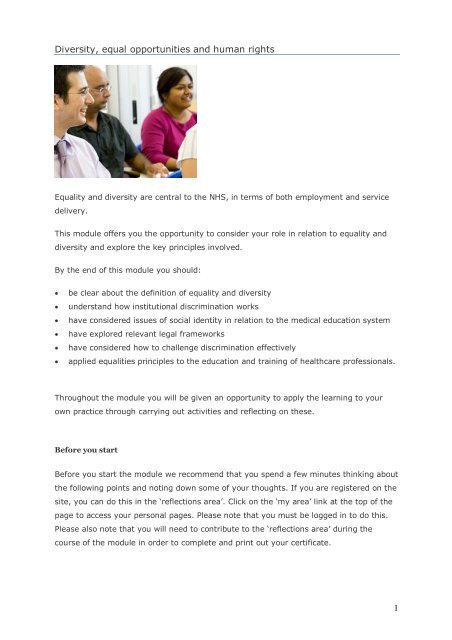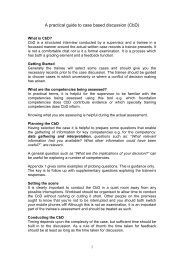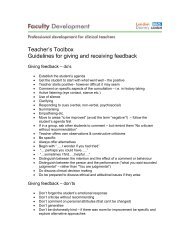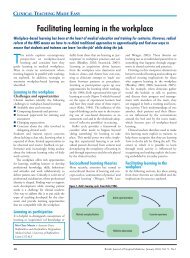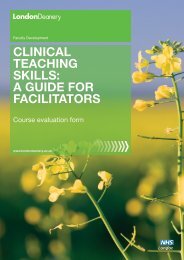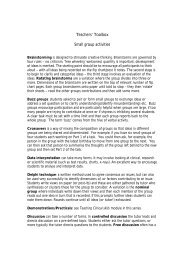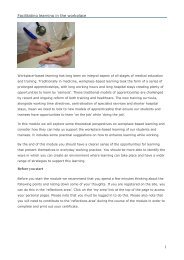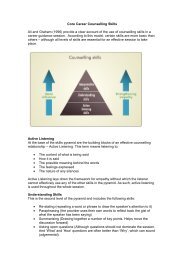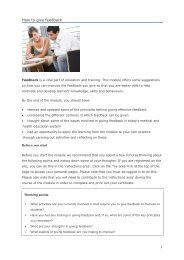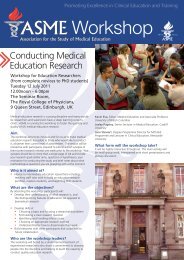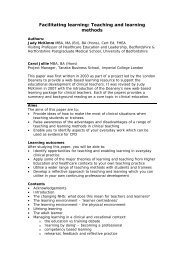Diversity, equal opportunities and human rights - Faculty Development
Diversity, equal opportunities and human rights - Faculty Development
Diversity, equal opportunities and human rights - Faculty Development
You also want an ePaper? Increase the reach of your titles
YUMPU automatically turns print PDFs into web optimized ePapers that Google loves.
<strong>Diversity</strong>, <strong>equal</strong> <strong>opportunities</strong> <strong>and</strong> <strong>human</strong> <strong>rights</strong>Equality <strong>and</strong> diversity are central to the NHS, in terms of both employment <strong>and</strong> servicedelivery.This module offers you the opportunity to consider your role in relation to <strong>equal</strong>ity <strong>and</strong>diversity <strong>and</strong> explore the key principles involved.By the end of this module you should:• be clear about the definition of <strong>equal</strong>ity <strong>and</strong> diversity• underst<strong>and</strong> how institutional discrimination works• have considered issues of social identity in relation to the medical education system• have explored relevant legal frameworks• have considered how to challenge discrimination effectively• applied <strong>equal</strong>ities principles to the education <strong>and</strong> training of healthcare professionals.Throughout the module you will be given an opportunity to apply the learning to yourown practice through carrying out activities <strong>and</strong> reflecting on these.Before you startBefore you start the module we recommend that you spend a few minutes thinking aboutthe following points <strong>and</strong> noting down some of your thoughts. If you are registered on thesite, you can do this in the ‘reflections area’. Click on the ‘my area’ link at the top of thepage to access your personal pages. Please note that you must be logged in to do this.Please also note that you will need to contribute to the ‘reflections area’ during thecourse of the module in order to complete <strong>and</strong> print out your certificate.1
Thinking points• What activities are you currently involved in that directly relate to <strong>equal</strong>ity <strong>and</strong> diversity?• What areas of your role do you think that <strong>equal</strong>ity <strong>and</strong> diversity has most impact on?• What areas of <strong>equal</strong>ity <strong>and</strong> diversity within your role do you feel most confident about?• What areas of <strong>equal</strong>ity <strong>and</strong> diversity within your role do you hope to improve?What is <strong>equal</strong>ity <strong>and</strong> diversity?Although sometimes used interchangeably, the terms ‘<strong>equal</strong>ity’ <strong>and</strong> ‘diversity’ are not thesame.Equality is about ‘creating a fairer society, where everyone can participate <strong>and</strong> has theopportunity to fulfil their potential’ (DH, 2004). It is about identifying patterns ofexperience based on group identity, <strong>and</strong> the challenging processes that limit individual’s‘potential’ health <strong>and</strong> life chances.For example, occupational segregation. Women make up almost 75% of the NHSworkforce but are concentrated in the lower-paid occupational areas: nursing, alliedhealth professionals (AHPs), administrative workers <strong>and</strong> ancillary workers (DH, 2005).People from black <strong>and</strong> minority ethnic groups comprise 39.1% of hospital medical staffyet they comprise only 22.1% of all hospital medical consultants (DH, 2005).An <strong>equal</strong>ities approach underst<strong>and</strong>s that our social identity – in terms of gender, race,disability, age, social class, sexuality <strong>and</strong> religion – will impact on our life experiences.<strong>Diversity</strong> literally means difference. When it is used as a contrast or addition to <strong>equal</strong>ity,it is about recognising individual as well as group differences, treating people asindividuals, <strong>and</strong> placing positive value on diversity in the community <strong>and</strong> in theworkforce.Historically, employers <strong>and</strong> services have ignored certain differences. However, individual<strong>and</strong> group diversity needs to be considered in order to ensure that everybody‘s needs<strong>and</strong> requirements are understood <strong>and</strong> responded to within employment practice <strong>and</strong>service design <strong>and</strong> delivery.One way in which organisations have responded to the issue of diversity in recent yearshas been the development of flexibility in working practices <strong>and</strong> services. For example,an employer may allow an employee to work a flexible working pattern to accommodate2
child care arrangements, or a GP surgery may offer surgeries at the weekends inaccommodate those who work full time during the week.These approaches recognise that in order to be inclusive <strong>and</strong> <strong>equal</strong> to all, organisationsmay need to respond differently to individuals/groups.Therefore, a commitment to <strong>equal</strong>ity in addition to recognition of diversity means thatdifferent can be <strong>equal</strong>.Why is <strong>equal</strong>ity <strong>and</strong> diversity important?Equality <strong>and</strong> diversity is becoming more important in all aspects of our lives <strong>and</strong> work fora number of reasons.• We live in an increasingly diverse society <strong>and</strong> need to be able to respondappropriately <strong>and</strong> sensitively to this diversity. Learners in the healthcare setting willreflect this diversity around gender, race <strong>and</strong> ethnicity, disability, religion, sexuality,class <strong>and</strong> age.• Your organisation believes that successful implementation of <strong>equal</strong>ity <strong>and</strong> diversity inall aspects of work ensures that colleagues, staff <strong>and</strong> students are valued, motivated<strong>and</strong> treated fairly.• We have an <strong>equal</strong>ity <strong>and</strong> <strong>human</strong> <strong>rights</strong> legal framework covering employmentpractices <strong>and</strong> service delivery <strong>and</strong> we need to ensure we work within this <strong>and</strong> avoiddiscrimination.DiscriminationDiscrimination is less favourable or bad treatment of someone because of one or moreaspects of their social identity.Underst<strong>and</strong>ing how discrimination can impact on individuals’ lives is essential to preventpotential discrimination within in teaching <strong>and</strong> learning situations <strong>and</strong> ensure that youare confident in dealing with discrimination issues if <strong>and</strong> when they arise.Our social identity comprises our:• gender• race or ethnicity• sexuality• religion or faith• age3
• class• disability.While we can face discrimination because of any of these aspects, it is important that wealso identify the links between social identities <strong>and</strong> individuality <strong>and</strong>/or a state <strong>and</strong>situation. Bad treatment can be multi-layered <strong>and</strong> occur because of:• an aspect of individuality, e.g. some aspect of personal appearance, size, personallikes, etc.• our state/situation, e.g. homelessness, being a lone parent, misuse of drugs oralcohol, citizen status, health, etc.Thinking points• Are you aware of any incidents when you have observed discrimination taking place in theclinical teaching setting?• What social identities were involved?• How did discrimination work?• What action, if any, did you take?Valuing diversityIt is important that you consider how an individual’s social identity may impact on theirexperience of the programme/teaching session of clinical activity in which the learner isengaged.The ways in which discrimination works include stereotyping, making assumptions,patronising, humiliating <strong>and</strong> disrespecting people, taking some people less seriously.To ensure that we value diversity <strong>and</strong> consider the individual’s identity appropriately inclinical teaching, the following principles may be useful:• recognise that we need to treat all learners as individuals <strong>and</strong> respond to them, <strong>and</strong>their social identity, in an individual manner• underst<strong>and</strong> that treating people fairly does not mean treating people in the same way– we need to recognise difference <strong>and</strong> respond appropriately• respect all learners regardless of their social identity• try to increase our knowledge <strong>and</strong> underst<strong>and</strong>ing of aspects of social identity thatmay be different from our own4
• avoid stereotyping or making assumptions about learners based on their socialidentity• recognise that some course content may impact on some learners in anegative/difficult way because of an aspect of their social identity• recognise that the course structure, e.g. timing of lectures, unsociable hours,weekend working, <strong>and</strong> so on, may impact on some learners more than others due totheir social identity• recognise that your own social identity may impact on learners in different ways• avoid using inappropriate <strong>and</strong> disrespectful language relating to social identity.Thinking points• How could your own social identity impact on learners?• How do you take your social identity into account in your work?• How do you learn about learners’ backgrounds <strong>and</strong> experiences?• Would all your learners find you <strong>equal</strong>ly approachable?• What do you think the reasons for this might be?Institutional discriminationInstitutional discrimination is concerned with discrimination that has been incorporatedinto the structures, processes <strong>and</strong> procedures of organisations, either because ofprejudice or because of failure to take into account the particular needs of different socialidentities.Three features distinguish institutional discrimination from other r<strong>and</strong>om individual formsof bad treatment.• Triggered by social identity– the discrimination impacts on groups (or individuals because they are members of thatgroup).• Systematic – it is built into:– laws, rules <strong>and</strong> regulations. For example, selection criteria for jobs or courses, lawssuch as the Minimum Wage, pension regularities, etc.– ‘the way we do things round here’, including the use of authority <strong>and</strong> discretion, e.g.how training <strong>opportunities</strong> are allocated, how flexibility in learning practices is authorised– the popular culture <strong>and</strong> ways of describing ‘normality’, e.g. long working hoursculture/expectations.• Results in patterns– incidents of discrimination may appear isolated or r<strong>and</strong>om but where institutional5
discrimination occurs they are part of a wider pattern of events which often may behidden. Patterns of discrimination can often be surfaced by effective organisationalinformation relating to social identity. For example:• which groups of people get promoted in an organisation?• which groups of people get accepted onto a training course?• which groups of people leave an organisation after six months of employment?Questions such as this may point to some people experiencing the organisation in adifferent/more negative way than others.Thinking point• How could discrimination be built into your own organisation? Consider issues such as:– timing of lectures or meetings– allocation of work or development/training <strong>opportunities</strong>– recruitment practices.Case studiesThe following case studies are to help you place your underst<strong>and</strong>ing of <strong>equal</strong>ity, diversity<strong>and</strong> discrimination in context. You may wish to jot down your response to these in ‘myarea’.Suggestions of possible approaches are provided.Case study oneA second-year student has recently married <strong>and</strong> converted to Judaism. Her husb<strong>and</strong>follows the Jewish faith <strong>and</strong> converting was something she felt was really important toher new relationship. The student has mentioned that Fridays are now very difficult forher as she should really leave lectures early in order to begin to observe the Sabbath.The student has previously demonstrated no performance concerns. She has written aformal letter to you requesting permission to leave lectures early on Friday afternoons.She has stated that she will ensure she will take responsibility to catch up with anymissed work.• How should you respond?• What issues do you consider in your response?Please click here to see our suggested answer.6
Case study twoYou have observed that a Muslim trainee never has any eye contact with femalecolleagues or patients when he is talking to them. You are concerned that this will impacton his relationships. He does have direct eye contact with male colleagues.• How should you deal with this issue?• What issues should you consider in your response?Please click here to see our suggested answer.Case study threeA trainee has approached you with a request not to have to deal with a particular patientbecause they feel she is treating them in a racist manner.• Can they refuse to deal with a patient on these grounds?Please click here to see our suggested answer.Case study fourIn a supervised session a student expresses a concern to you. They have recentlydisclosed their sexuality to a fellow student who they have always got on well with. Theircolleague was surprised <strong>and</strong> stated that they have a strong moral objection to lesbians<strong>and</strong> gay men. They recognised the need to treat others with respect regardless of theirsexuality, so while they felt it was not acceptable to be a lesbian they neverthelesswanted to maintain a positive relationship with their colleague. They requested that thelesbian student should help in this by not referring greatly to their sexuality again.• Is this response acceptable?Please click here to see our suggested answer.Case study fiveA trainee was diagnosed with depression about a year ago. She did not tell you untilthree months ago, when she confided in you about what she was experiencing <strong>and</strong> thetreatment she was getting from her doctor <strong>and</strong> therapist. A month ago the learner wassigned off on sick leave. She returned to work last week but is overwhelmed. She isdetermined, though, to carry on with her training.• What support can you provide to her?Please click here to see our suggested answer.7
The legal contextAs a clinical teacher you will want to ensure that you underst<strong>and</strong> the legal frameworkregarding <strong>equal</strong>ity, <strong>and</strong> that you can relate this framework to your everyday role. The UKframework has two elements to it: the anti- discriminatory framework (which givesindividuals a route to raise complaints of discrimination around employment <strong>and</strong> servicedelivery) <strong>and</strong> the public duties (which place a proactive duty on organisations to addressinstitutional discrimination).Overview of anti-discriminatory framework• Sex Discrimination Act 1975• Race Relations Act 1976• Disability Discrimination Act 1995• Employment Equality (Sexual Orientation) <strong>and</strong> (Religious Belief) Regulations 2003• Employment Equality (Age) Regulations 2006• Equality Act 2006 (covers service delivery in relation to sexual orientation <strong>and</strong>religious belief)It is important to note that at the current time, age legislation only protects individuals inthe area of employment <strong>and</strong> not service delivery.• The SEN <strong>and</strong> Disability Act 2001The SEN <strong>and</strong> Disability Act 2001 extended the Disability Discrimination Act 1995 toeducation with effect from September 2002. This act requires teachers to explore theprovision of reasonable adjustments for students who may have disabilities, includinglearning disabilities, to enable them to participate effectively.Who is protected?Gender Race/ethnicity DisabilityWomen, men, people inrelation to genderreassignmentAnyone in relation to ethnicorigin, nationality, colour orcultureAnyone with an impairment that has asubstantial <strong>and</strong> long-term effect ontheir ability to carry out day-to-dayactivitiesSexuality Religion/belief AgeLesbians, gay men, bisexual<strong>and</strong> heterosexual peopleAny one in relation to religious or philosophicalbelief, including not having a particular religion orAnyone, ofany age8
eliefKey legal principlesOut of the legal framework arise a number of key principles:• direct discrimination• indirect giscrimination• harassment• reasonable adjustment• positive action• Genuine Occupational Qualification• victimisation.Public dutiesPublic bodies are also bound to a number of duties. These apply to all public bodies,including local authorities, education, police forces, national health services, NHS trusts<strong>and</strong> bodies. It is through the implementation of these public duties that organisations willidentify <strong>and</strong> address institutional discrimination.The duties were brought in under the following legislation: Race Relations AmendmentAct (2000); Disability Discrimination Act (2005); Equality Act (2006). Each of the publicduties requires organisations to:• produce a (race, disability <strong>and</strong> gender) <strong>equal</strong>ity scheme• carry out impact assessments on their functions, policies <strong>and</strong> practices• carry out <strong>equal</strong>ities monitoring <strong>and</strong> take action to redress any imbalance• publish the results of any work undertaken.A summary of the public duties is provided below.Race Disability GenderEliminate unlawfuldiscriminationEliminate unlawful discriminationPromote <strong>equal</strong>ity of opportunityPromote <strong>equal</strong>ity ofopportunityPromote <strong>equal</strong>ity of opportunityEnsure that they do notdiscriminate unlawfully betweenwomen <strong>and</strong> men, when carrying9
out their employment or servicefunctionsPromote goodrelations betweendifferent racialgroupsPromote positive attitudes towardsdisabled people <strong>and</strong> encouragetheir participation in public lifeTake account of disabled people’simpairments, even when thisinvolves treating a disabled personmore favourably than othersFor full explanation of each individual piece of legislation follow the following links:Equality <strong>and</strong> Human Rights CommissionDepartment of Health – Equality <strong>and</strong> Human RightsChallenging discrimination in the teaching contextWithin your role as a clinical teacher you will at times be required to challenge learnersover their behaviour because you feel it is potentially discriminatory.You are required to challenge in order to:• ensure you create a learning environment that is free of discrimination <strong>and</strong> thatvalues difference• reinforce the policies <strong>and</strong> procedures of your organisation• ensure you do not breach the <strong>equal</strong>ities legal framework.Knowing what to challenge, <strong>and</strong> when to challenge, can be tricky <strong>and</strong> open to personalinterpretation. There are some non-negotiables re inappropriate language/behaviour e.g.swearing, language that is racist/sexist/homophobic, etc. We can often find debate overquestions such as ‘what constitutes inappropriate banter?’ or ‘They meant no offence bya comment – do I still need to challenge?’Not challenging is not a neutral act – it can be seen as colluding behaviour.10
Guiding principles re challengingIf in doubt about whether you should challenge someone’s behaviour or not, consider thefollowing.• Is the banter/joke/comment excluding anyone or aimed at anyone in order to ridiculethem?• Could someone be offended by the behaviour?• Lack of intention is not an excuse for behaviour. You are required to consider <strong>and</strong>manage the effect of behaviour.• Is the banter/joke/behaviour open to misinterpretation or misunderst<strong>and</strong>ing?How to challengeThere is no definite way to challenge inappropriate behaviour <strong>and</strong> no doubt you will findyour own approach to challenging effectively. The following may be useful to consider.• Don’t punish or blame – say what is better.• Underst<strong>and</strong> your audience. Think about your role in the situation – clinicalpractitioner, colleague, manager – <strong>and</strong> consider this in your approach.• State your position: ‘That’s disrespectful; we don’t talk about patients like that.’• Underst<strong>and</strong> the situation. Do you challenge there <strong>and</strong> then, or quietly at a later date?What will be most effective for the person involved/for those witnessing the incident?Case studiesSometimes you need to respond to remarks <strong>and</strong> situations that might be discriminatory.The next exercise gives you an opportunity to practise some skills <strong>and</strong> strategies <strong>and</strong>consider good practice in these situations.What issues are raised by the following situations?1. You observe a trainee talking to a patient with learning disabilities. The patient has aspeech impairment which means that his speech is slow. The trainee continuallyinterrupts him <strong>and</strong> finishes his sentences for him.2. A learner has raised with you that they do not feel confident when discussing disabilityissues with patients as they are not sure they are using the latest ‘pc’ language <strong>and</strong>terminology relating to this group. They are worried they may be open to challenge <strong>and</strong>not have the knowledge or confidence to respond. You recognise that this could be anissue for other learners in your group.11
3. You have noticed that a trainee tends to make a number of assumptions whenreferring to patients’ social identity. For example she often says things like ‘Asian peopledo this’ or ‘gay men are known for doing that’. You are worried it may demonstrateunderlying issues.4. A tutorial has just begun <strong>and</strong> a student makes a joke about Polish people beingeverywhere. The group laughs awkwardly <strong>and</strong> no one challenges.5. The st<strong>and</strong>ard of college work produced by a student has recently shown a markeddecline. When you talk to the learner about this she says that she is experiencing racistbehaviour from another learner on the course <strong>and</strong> is finding this impossible to cope with.Please see our suggested responses to the above.Human <strong>rights</strong>Human <strong>rights</strong> are the basic <strong>rights</strong> <strong>and</strong> principles that belong to every person in theworld. ‘They are based on the core principles of dignity, fairness, <strong>equal</strong>ity, respect <strong>and</strong>autonomy’ (E <strong>and</strong> HRC, 2008). Human <strong>rights</strong> protect an individual’s freedom to controltheir day-to-day life, <strong>and</strong> effectively participate in all aspects of public life in a fair <strong>and</strong><strong>equal</strong> way.Human <strong>rights</strong> help individuals to flourish <strong>and</strong> achieve potential through:• being safe <strong>and</strong> protected from harm• being treated fairly <strong>and</strong> with dignity• being able to live the life you choose• taking an active part in your community <strong>and</strong> wider society (E <strong>and</strong> HRC, 2008).Intrinsic to these statements should be the principles of <strong>equal</strong>ity <strong>and</strong> diversity.Since 1998 the UK has also included <strong>human</strong> <strong>rights</strong> within its legal framework. TheHuman Rights Act applies to all public authorities <strong>and</strong> bodies performing a publicfunction. The Human Rights Acts places the following responsibility on your organisation.• Organisations must promote <strong>and</strong> protect individuals’ <strong>human</strong> <strong>rights</strong>. This meanstreating people fairly, with dignity <strong>and</strong> respect while safeguarding the <strong>rights</strong> of the widercommunity.• Organisations should apply core <strong>human</strong> <strong>rights</strong> values, such as <strong>equal</strong>ity, dignity,privacy, respect <strong>and</strong> involvement, to all organisational service planning <strong>and</strong> decisionmaking.12
The Human Rights Act provides a complementary legal framework to the antidiscriminatoryframework <strong>and</strong> the public duties.Visit the Equality <strong>and</strong> Human Rights Commission website for useful resources <strong>and</strong>information.Taking it backBack in your own organisation• Ensure that there are policies in place to deal with complaints about discrimination onany grounds.• Discuss <strong>equal</strong>ities with the student body or those representing doctors in training.• Ensure that students or doctors in training know where to go if they have concernsabout discrimination.• Ensure that there are adequate procedures in place for assessing <strong>and</strong> managing theneeds of students or training doctors with disabilities.• Ensure that complaints made are properly dealt with <strong>and</strong> proper records kept (whatmay seem to be a small incident once may be part of a pattern).• Ensure that these issues can be discussed in as open a way as possible within aninstitution, although of course, specific incidents must be dealt with confidentially.• Give people feedback if they are complained about. They may be doing somethingthat can easily be changed.CongratulationsYou have now reached the end of the module. Provided you have entered something intoyour log you can now print your certificate. To generate your certificate please go to ‘myarea’ <strong>and</strong> click on ‘complete’ in the course status column. Please note, you will not beable to print your certificate unless you have entered something in your ‘reflectionsarea’.Please now take a moment to evaluate the course <strong>and</strong> enter your comments below.13
Further informationThis module was written by Helen Webb, senior consultant at Equality Works, withadditional material by Judy McKimm.Teachers’ ToolkitThe following guidelines are useful in ensuring that clinical practitioners create a positive<strong>and</strong> non-discriminatory learning environment.Guidelines for identifying discriminationGuidelines on using language <strong>and</strong> imagesGuidelines for positively acknowledging differenceReferencesDepartment of Health (2004) Sharing the Challenge, Sharing the Benefits – <strong>equal</strong>ity <strong>and</strong>diversity in the medical workforce directorate. Department of Health, London.Department of Health (2005) Promoting Equality <strong>and</strong> Human <strong>rights</strong> in the NHS: a guidefor non-executive directors of boards. Department of Health, London.Lewis V <strong>and</strong> Habeshaw S (1990) 53 Interesting Ways to Promote Equal Opportunities inEducation. Technical <strong>and</strong> Educational Services, BristolEquality <strong>and</strong> Human Rights Commission website 2008 – Human Rights sectionExplore around this topicDepartment of Health Single Equality Scheme 2007–2010Some examples of how the NHS has mainstreamed <strong>equal</strong>ity <strong>and</strong> diversity into its workare:• Improving Working LivesAn organisational change programme that aims to make the NHS an ‘employer of choice’– particularly for women who make up the majority of staff.14
• Positively DiverseA strategic approach to managing <strong>and</strong> improving <strong>equal</strong>ity of opportunity for staff, <strong>and</strong>benefiting from the diversity of culture, skills <strong>and</strong> experience they bring to theworkplace.• The Vital Connection <strong>equal</strong>ities frameworkAims to put values of <strong>equal</strong>ity, fair treatment <strong>and</strong> social inclusion firmly at the centre ofNHS workforce policy <strong>and</strong> practice.A gateway to information on the DH’s <strong>equal</strong>ities work on race, sexual orientation, genderidentity, <strong>and</strong> disability.'You can make a difference: improving hospital services for disabled people’ DisabilityRights Commission/ NHS, 2004Age <strong>and</strong> the workplace – putting the employment <strong>equal</strong>ity guidelines 2006 into practice’ACASMaternity Care for Lesbian Mothers, Position Paper 22, Royal College of Midwives, 2000(reviewed 2005)Department of Trade <strong>and</strong> Industry – discrimination in employment pagesCases for change – anti discriminatory practices, National Institute for Mental Health inEngl<strong>and</strong>, 2007Underst<strong>and</strong>ing the DDA – a guide for colleges, universities <strong>and</strong> adult community learningproviders15
Course glossaryAimAn aim in educational terms, is a brief statement of intent, indicating the scope <strong>and</strong> range ofintended learning outcomes that the educational episode has been structured to address.AssessmentAssessment is the term used to indicate an appraisal of students' performance. Typical formalassessments in medicine include written examinations, Multiple choice questionnaires(MCQ), observations of clinical or communication skills, Objective Structured ClinicalExaminations (OSCEs) <strong>and</strong> Multi-Source Feedback (MSF). Assessments may be summative(where the marks gained contribute to a formal grade or award) or formative (where the focusis on providing feedback for ongoing development).ClassClass refers to hierarchical differences between individuals or groups in societies or cultures .Factors that determine class may vary widely from one society to another. However, economicdisadvantage <strong>and</strong> barriers to access servces are major issues within class discrimination.DisabilityThe definition of disability outlined by the Disability Discrimination Act 1995 covers anyonewith an impairment which has a substantial <strong>and</strong> long-term (at least 12 months) effect on theirability to carry out day-to-day activities such as mobility, speech, hearing or eyesight, memoryor ability to concentrate, learning or underst<strong>and</strong>, continence. The definition also includeslong-term illnesses such as HIV, cancer<strong>and</strong> multiple sclerosis, from the point of diagnosis.DiscriminationDirect discrimination - Direct discrimination is less favourable treatment on the grounds ofsomeone’s social identity. If the treatment results in an adverse impact <strong>and</strong> cannot bejustified. Indirect Discrimination - Indirect discrimination is when a rule, condition orrequirement is applied to everyone but some people find this more difficult to fulfil. The rule,condition or requirement causes an adverse impact <strong>and</strong> cannot be justified.<strong>Diversity</strong><strong>Diversity</strong> literally means difference. When it is used as a contrast or addition to <strong>equal</strong>ity, it isabout recognising individual as well as group differences, treating people as individuals, <strong>and</strong>placing positive value on diversity in the community <strong>and</strong> in the workforce. Historically,employers <strong>and</strong> services have ignored certain differences.EqualityEquality is about ‘creating a fairer society, where everyone can participate <strong>and</strong> has theopportunity to fulfil their potential’ (DH 2004). It is about identifying patterns of experiencebased on group identity, <strong>and</strong> the challenging processes which limit individuals “potential”health <strong>and</strong> life chances. An <strong>equal</strong>ities approach underst<strong>and</strong>s that our social identity – in termsof gender, race, disability, age, social class, sexuality <strong>and</strong> religion – will impact on our lifeexperiences.Genuine Occupational QualificationIf an employer requires a person of a specific gender or race / ethnic identity for personalservices or ‘authenticity’, they can request a Genuine Occupational Qualification (GOQ) fromthe Equal Opportunities Commission or the Commission for Racial Equality.HarassmentHarassment occurs if A’s conduct has the purpose or effect of violating B’s dignity or ofcreating an offensive environment – one that is intimidating, hostile, degrading orhumiliating.16
Positive ActionIn the areas of training, recruitment, <strong>and</strong> membership of organisations such as trade unions, ifa gender or racial group has been under-represented in the previous 12 months, employerscan: • Offer selective training programmes; • Advertise to encourage applications; • Train staffresponsible for selection. This is positive action. Offering someone a job or promotion on thebasis of their gender or race is positive discrimination <strong>and</strong> is illegal. Quotas (as opposed totargets) are also illegal.PrejudicePrejudice ('prejudging') describes the feelings that individuals have about other individuals orgroups, feelings that are often unfounded <strong>and</strong> based on stereotypes. We all have prejudicesbased on our own experiences <strong>and</strong> indirect experience e.g. through the mass media, butusually learn to overcome these feelings, or at least control how we behave with others <strong>and</strong>what we say. Discrimination can be seen as 'prejudice put into practice', where people let theirprejudices affect what they say about <strong>and</strong> how they behave towards others.Racial groupsA racial group is a group of people defined by their race, colour, nationality (includingcitizenship), ethnicity or national origins.Reasonable adjustmentReasonable adjustments are steps which an employer/service provider may have to take inrelation to a disabled person in order to comply with the Act. For example: • Makingadjustments to premises • Allocating some of the disabled person’s duties to another person •Altering their working hours • Allowing them to be absent during working hours forrehabilitation, assessment or treatment • Acquiring or modifying equipment • Modifyinginstructions or reference manuals • Modifying procedures for testing or assessment •Providing a reader or interpreterSexualityThis term refers to the general preference of people. It is an alternative term for 'sexualorientation' <strong>and</strong> is the term currently used.VictimisationVictimisation arises where a person treats another less favourably because that person hasasserted their <strong>rights</strong> under the SDA or RRA; if, for example, that person has broughtproceedings, or given evidence or information in connection with proceedings, under eitherAct.17
Learning activitiesSelect one or more of the activities below to focus your attention on <strong>equal</strong>ity <strong>and</strong>diversity issues within your role <strong>and</strong> put into practice some of your learning from themodule.1. Underst<strong>and</strong>ing discriminationSelect some of the key points <strong>and</strong> approaches from this module that you feel areimportant in ensuring you create a positive learning environment that is free ofdiscrimination <strong>and</strong> respectful of all learners’ social identities.Make a commitment to consider these points <strong>and</strong> approaches in relation to all aspects ofyour role with learners.List some of the advantages <strong>and</strong> challenges you encountered from your approach.2. The legal frameworkTest yourself on how much you know <strong>and</strong> underst<strong>and</strong> the legal framework. Answers areto be found at the end of the quiz.1. From the end of 2007, UK legislation offers protection against discrimination in whichof the following areas?a. ageb. disabilityc. genderd. religione. race/ethnicity/nationalityf. sexual orientationg. class.2. The concept of a ’reasonable adjustment’ to a job for a disabled employee or potentialemployee means that:a. employers now have to invest a lot of extra money on disabled employeesb. employers must explore the possibility of making a reasonable adjustment, if thiswould enable a disabled person to do a jobc. all disabled people who apply for a position must be interviewedd. employers have to employ a 3% quota of disabled employees.18
3. On average, what proportion of patients, service users <strong>and</strong> visitors to a hospital aredisabled?a. 7%b. 14%c. 33%d. 55%4. Age discrimination legislation means that:a. employers can no longer make anyone retireb. employers can set a normal retirement age, <strong>and</strong> an employee can request to workbeyond thisc. each employee can select their own retirement age.5. A Gender Equality Scheme is:a. a document that all public bodies must produce <strong>and</strong> update at least every three yearsb. a document that is produced by the Equality <strong>and</strong> Human Rights Commissionc. a document that explains how an organisation intends to fulfil its duty to achievegender <strong>equal</strong>ity in employment <strong>and</strong> service deliveryd. a document that sets out gender quotas for staff employment.6. A racist incident is:a. any incident that is perceived to be racist by the victim or any other personb. any incident where racist intention can be demonstratedc. any incident where two people of different races are involved <strong>and</strong> there is adisagreement.7. Protection against religious discrimination at work means:a. you should not be subjected to harassment on the basis of your religionb. your employer should offer you a uniform which allows you to follow the dress code ofyour religion, unless there is a clear health <strong>and</strong> safety conflictc. you do not have to treat lesbian or gay patients if your religious beliefs mean that youbelieve their way of life is wrongd. you have the right to practise your faith whenever necessary while at work <strong>and</strong> youremployer must make provision for this.8. If people of a specific gender or ethnicity are under-represented in a particular job orgrade, an employer can undertake positive action. This means:a. people from the over-represented sex or ethnicity can be barred from applying forvacancies or promotion to those jobsb. training or development <strong>opportunities</strong> can be targeted at people from the underrepresentedgroup19
c. if there is a choice between two <strong>equal</strong>ly qualified c<strong>and</strong>idates, the person from theunder-represented group will get the job.9. Monitoring of patients, student <strong>and</strong> staff by gender, ethnicity <strong>and</strong> disability isnecessary because:a. it provides data for improving services <strong>and</strong> redressing in<strong>equal</strong>ityb. it means the Deanery has fulfilled its duty under the Race Relations Amendment Actc. it is part of a wider legal requirement under the general duties for public bodies.Answers – how did you do? (this should come up in a pop-up window)1. All options except g.2. b.3. c.4. b.5. a. <strong>and</strong> c.6. a.7. a. <strong>and</strong> b.8. b.9. a. <strong>and</strong> c.3. Your organisation’s approach to <strong>equal</strong>ity <strong>and</strong> diversityYou need to ensure that you are familiar with your own organisation’s policies <strong>and</strong>procedures regarding <strong>equal</strong>ity <strong>and</strong> diversity <strong>and</strong> dealing with discrimination.Find out what the policies say <strong>and</strong> consider how they relate to your role.If a learner reported an incidence of discrimination to you, what action would you berequired to take to ensure you dealt with the issue in a sensitive manner <strong>and</strong> alsofollowed your organisation’s approach?20


